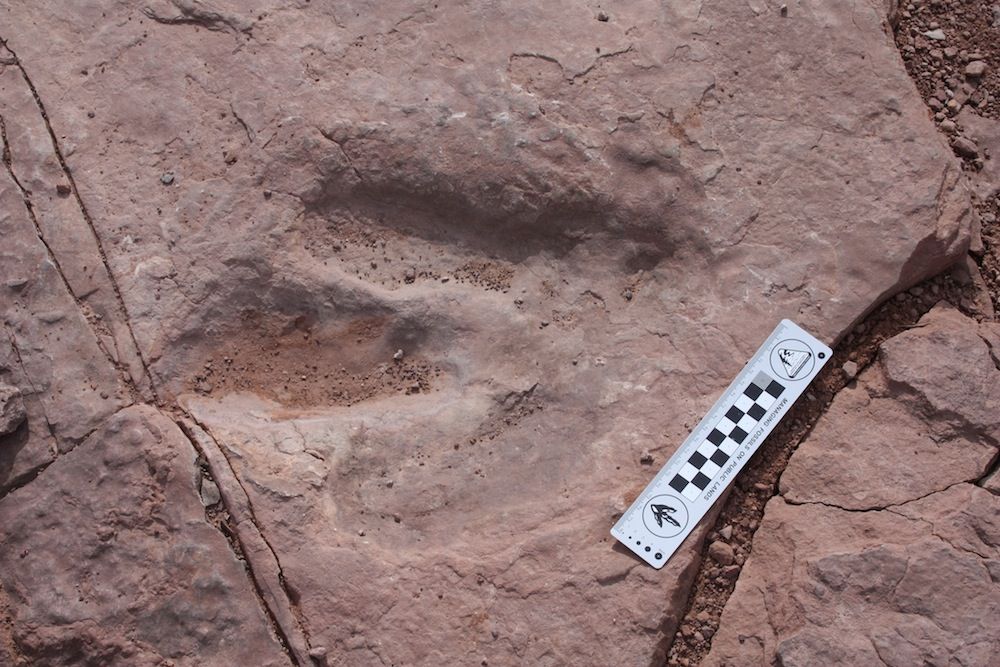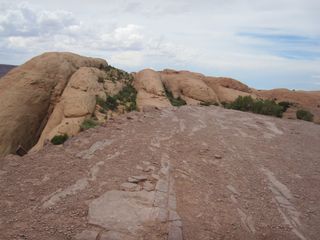'Priceless' Dinosaur Track Stolen Near Moab

A three-toed dinosaur track has vanished from public lands in Utah, and Bureau of Land Management officials are looking for help recovering the fossil.
Someone chiseled the track of a theropod (a family of meat-eating dinosaurs that included T. rex) out of the ground on a Jeep trail near Moab called Hell's Revenge. The spot is known for its smattering of about 20 dinosaur tracks daing back 190 million years.
"They're priceless to us," said Rebecca Hunt-Foster, a paleontologist at the BLM field office in Moab. "You can't replace them."
Track theft
The BLM became aware of the theft on Tuesday night, when a local outfitter who gave tours of the area noticed a triangular slab of rock about 1 foot long and 3 feet wide (30 by 90 centimeters) missing. [See Photos of Dinosaur Tracks in the Yukon]
"There are at least three different types of dinosaurs that have left tracks there," Hunt-Foster told Live Science. But the missing slab contained a clear theropod print.

Unfortunately, theft or damage to dinosaur tracks on public land is not unheard-of, said Aaron King, a BLM archaeologist at the Moab office.
Sign up for the Live Science daily newsletter now
Get the world’s most fascinating discoveries delivered straight to your inbox.
"It's pretty common on the whole Colorado plateau," King told Live Science. The Moab field office alone is responsible for 1.8 million acres of public land, he said, so, "we really have to rely on people's integrity" to protect resources.
Visitors to public lands regularly take dinosaur bones, tracks and even archaeological artifacts such as petroglyphs or pottery. They also attempt do-it-yourself molds of tracks, Hunt-Foster said, pouring silicon or latex into the prints. This often damages the tracks, she said. The BLM hopes to put signs in the area informing visitors about the tracks and warning them not to damage them.
Sometimes, looters take artifacts specifically to sell them, as with a case in Utah in 2009 when about two dozen people were charged with stealing Native American artifacts from public lands and creating phony papers to sell them. In other cases, people may not know that what they're doing is illegal.
"Some people might think they're just collecting them to take them home as a souvenir," Hunt-Foster said.
Illegal keepsakes
In fact, taking any artifact from public lands is strictly against the law, and is punishable with both fines and jail time, Hunt-Foster said.
"Inexpert collecting, or the failure to maintain precise information on the original location, rock type, or other conditions of a paleontological resource occurrence, can damage fossils, or cause them to lose their context, and therefore, much of their scientific value for research purposes," according to the BLM policy on managing archaeologist and paleontological resources.
Rarely, lost artifacts reappear. Visitors to Dinosaur Ridge, just west of Denver, Colo., can see a circular pit marring an impressive field of dozens of tracks where a pack of Iguanodon-like dinosaurs once roamed. The pit marks the spot where a long-ago thief stole a track. Years later, according to Dinosaur Ridge volunteers, that track turned up at the University of Colorado, Boulder. It had changed hands an unknown number of times and was being used as a doorstop. Today, it has been returned to the Dinosaur Ridge visitor's center.
There is some hope for Moab's lost track and other valuable artificats, according to King: Damage to public lands is starting to illicit greater public outrage. In 2013, two Utah Boy Scout leaders enraged people worldwide with a viral video showing them pushing over a 170-million-year-old rock formation called a "hoodoo" in Utah's Goblin Valley State Park. The two men were charged with criminal mischief and with aiding and abetting criminal mischief in January and will go to court in March. They face up to $5,000 in fines and five years in prison, according to news organization KSL.
There are no leads yet on the theropod track theft, but BLM officials hope that public attention will lead to answers. Anyone with knowledge about the theft is encouraged to call the Moab field office at 435-259-2100.
Follow Stephanie Pappas on Twitter and Google+. Follow us @livescience, Facebook & Google+. Original article on Live Science.

Stephanie Pappas is a contributing writer for Live Science, covering topics ranging from geoscience to archaeology to the human brain and behavior. She was previously a senior writer for Live Science but is now a freelancer based in Denver, Colorado, and regularly contributes to Scientific American and The Monitor, the monthly magazine of the American Psychological Association. Stephanie received a bachelor's degree in psychology from the University of South Carolina and a graduate certificate in science communication from the University of California, Santa Cruz.











